Dec. 23, 2019, marks the 100th anniversary of the birth of space artist Robert T. “Bob” McCall. Born in Columbus, Ohio, McCall combined his early interest in astronomy and aviation with an innate artistic talent that he nurtured with a scholarship to the Columbus Fine Art School. Working in a sign shop to earn extra money, McCall read science fiction magazines and journals about science and technology in his spare time. With the outbreak of World War II, McCall joined the Army Air Corps, stationed at Kirtland Field, now Kirtland Air Force Base, outside of Albuquerque, New Mexico. There he met and married his wife Louise and they soon had two daughters, Linda and Catherine. After the war, the McCalls moved to Chicago and Bob took a job as an advertising artist, and three years later they moved to New York so he could paint illustrations for magazines such as Life, The Saturday Evening Post, and Popular Science. The advent of the space program provided a natural next step in his career and in 1963 NASA selected McCall as one of the first artists in its new Art Program with other famous artists like Jamie Wyeth and Norman Rockwell.
As much as McCall loved painting technically accurate images of the evolving space program, he also relished letting his imagination wander into futuristic space scenes. In 1967, this caught the attention of director Stanley Kubrick, then working with noted science fiction writer Arthur C. Clarke on a film eventually titled 2001: A Space Odyssey. The film’s studio, Metro-Goldwyn-Mayer, Inc., asked McCall to produce promotional art for 2001 – his paintings of the pinwheel space station and the lunar base graced movie posters to advertise the release of the ground-breaking science fiction film in 1968.
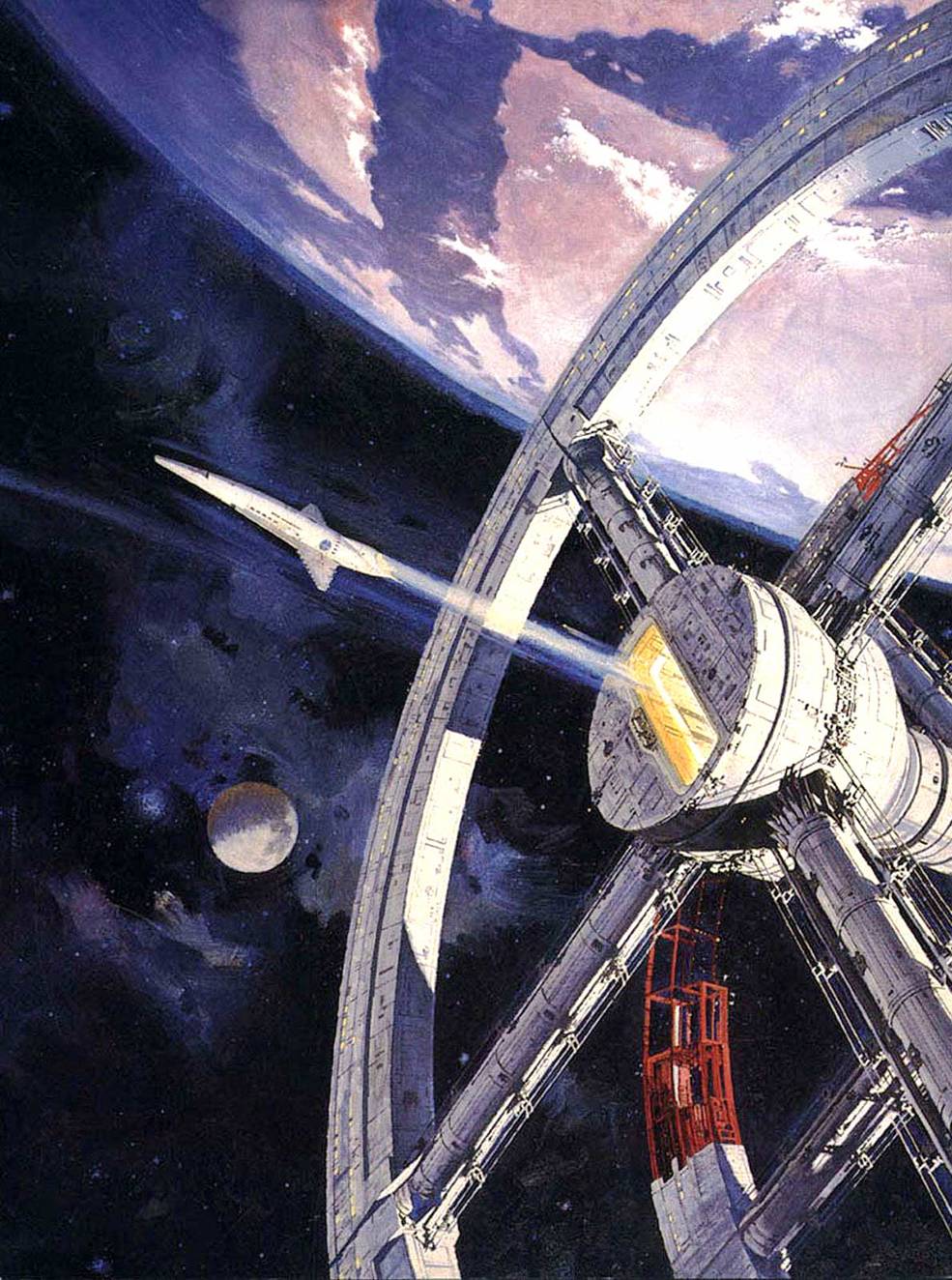

McCall’s artwork for the promotion of the film 2001: A Space Odyssey.
Credits: mccallstudios.com.
McCall’s work continued to alternate current space programs with visions of the future. He not only produced large paintings, eventually moving on to paint giant murals, but he also went to the opposite end of the size spectrum by painting stamps for the United States postal service. In 1971, he produced First Men on the Moon, a 7-by-9-foot oil painting of the Apollo 11 astronauts on the Moon as well as the first stamp cancelled on the Moon by the Apollo 15 astronauts, depicting them in their Lunar Rover.


Left: First Men on the Moon. Right: McCall’s first stamp depicting the Apollo 15 astronauts on the Moon – they cancelled the stamp while on the lunar surface.
Credits: mccallstudios.com, University of Arizona Museum of Art
In 1974, about a year before the actual event, McCall painted his impression of what the docking of an American and a Soviet spacecraft would look like during the Apollo-Soyuz Test Project (ASTP). In February 1975, while training at the Kennedy Space Center for their historic mission, the five ASTP crewmembers posed in front of McCall’s art. He later painted a different version of the docking to commemorate the mission on a postage stamp.
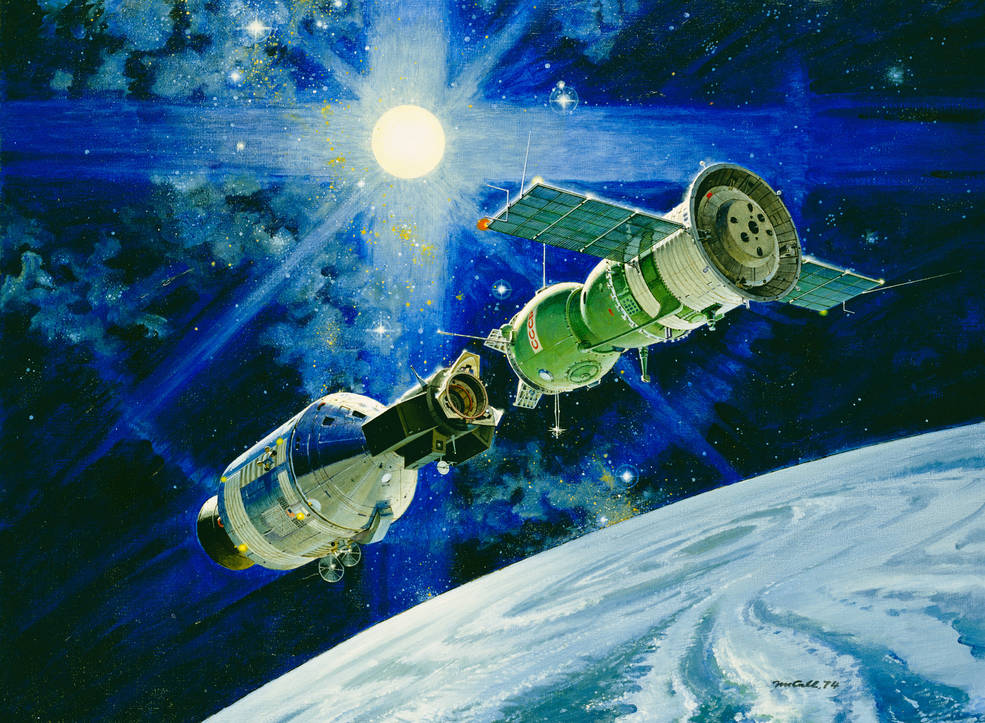

Left: Apollo-Soyuz Linkup. Right: The five ASTP crewmembers stand in front of
Apollo-Soyuz Linkup at Kennedy Space Center.
Michael Collins, former Apollo 11 astronaut and then Director of the Smithsonian Institution’s new National Air and Space Museum in Washington, DC, asked McCall to paint a mural for the facility. For his first mural, McCall spent eight months working on the 146-foot long uniquely L-shaped artwork, six stories tall at its highest point, completing it in 1976. The painting depicts McCall’s interpretation of the Big Bang as well as Apollo astronauts on the Moon. The larger-than-life depiction of an astronaut holding an American flag on the Moon is according to McCall based on Apollo 17 astronaut Eugene A. Cernan. Because of its very public location, an estimated 10 million visitors view the mural every year.
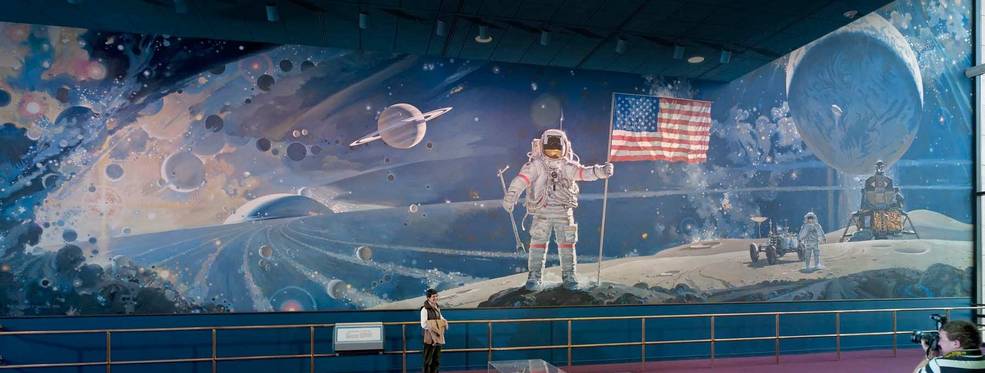
The Space Mural – A Cosmic View, at the National Air and Space Museum.
Credits: mccallstudios.com.
To commemorate 30 years of aircraft testing and operations at the NASA Dryden Flight Research Center, now the Armstrong Flight Research Center, in Lancaster, California, McCall painted his mural The Spirit of Flight Research in 1977. The 10-by-20-foot painting depicts the aircraft flown during the center’s first 30 years of operation. For the center’s 50th anniversary, McCall painted a smaller 8-by-10-foot work entitled Accepting the Challenge of Flight.


McCall’s artwork at Armstrong Flight Research Center (left) The Spirit of Flight Research, and (right) Accepting the Challenge of Flight.
Credits: mccallstudios.com
The next major project for McCall took him to the Johnson Space Center (JSC) in Houston. Christopher C. Kraft, JSC Director, commissioned McCall to paint a mural on the outside of the center’s auditorium, later named after Congressman Olin E. Teague of Texas who served on committees that oversaw NASA’s activities. In 1979, McCall spent several months at JSC painting the mural entitled Opening the Space Frontier – The Next Giant Step, illustrating NASA’s human space flight program, past, present, and future. He painted several JSC employees in the mural and used astronauts John W. Young and Judith A. Resnik as inspiration for two of the painting’s central figures. Astronaut Alan L. Bean, at the time a budding space artist, contributed by painting the astronaut pin in the mural. Dedication of the mural took place on June 19, 1979, and at the time the building housing the auditorium also housed the JSC Visitors Center, allowing the general public to view the mural.

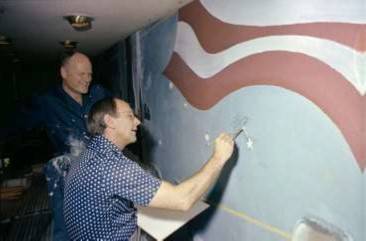
Left: McCall putting the finishing touches on his mural outside the JSC auditorium.
Right: McCall getting help from astronaut and fellow space artist Bean.
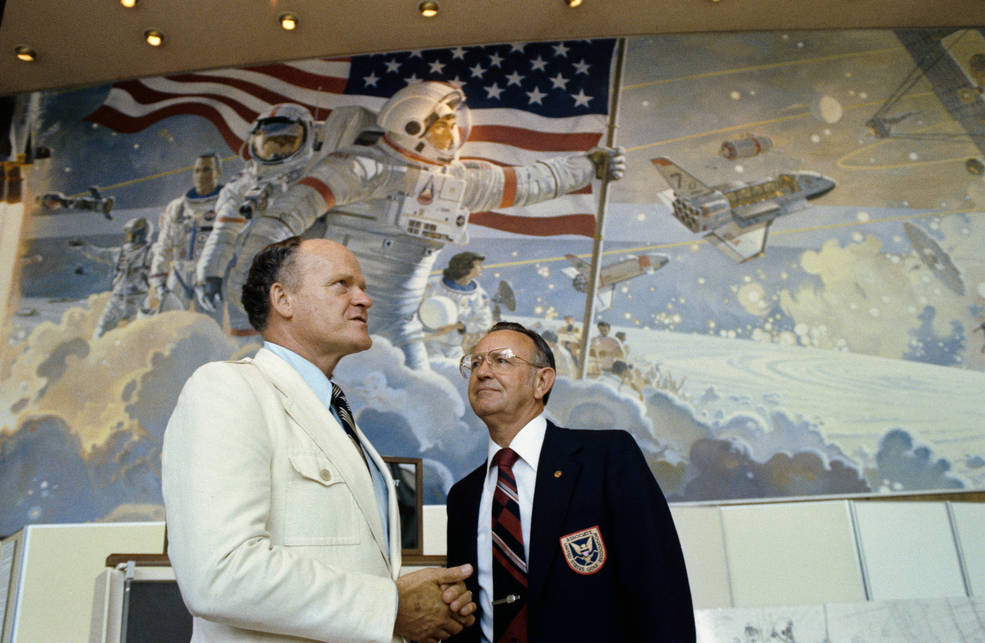

Left: McCall with JSC Director Kraft at the dedication of his mural at JSC.
Right: McCall with astronaut Resnick at the dedication of his mural at JSC.

Opening the Space Frontier – The Next Giant Step mural at JSC.
His interest in aviation led McCall to design a mural for the 75th anniversary of the NASA Langley Research Center in Hampton, Virginia. Painted in 1992, the painting entitled Expanding the Frontiers of Flight illustrates the contributions that Langley made in the field of aviation. It hangs in the Virginia Air and Space Center in Hampton.

Expanding the Frontiers of Flight, at the Virginia Air and Space Center, commemorating the 75th anniversary of the Langley Research Center.
Credits: mccallstudios.com
In addition to his murals and postage stamps, McCall famously designed patches for space missions as well as institutions. His first mission patch, for the Apollo 17 final Moon landing mission, uniquely incorporated the profile of the second century Roman statue of Apollo Belvedere along with more traditional symbols such as an American bald eagle (in outline form) and stars and stripes. McCall designed several Space Shuttle patches, among them STS 1, the first mission, and STS 71, the first Shuttle-Mir docking. With the help of artists Tim Gagnon and Jorge Cartes, the crew of STS 133, the final flight of Space Shuttle Discovery in 2011, completed their patch based on sketches McCall had drawn prior to his death, the final creations of his long and prodigious career.




Selection of mission patches that McCall designed. Left to right: Apollo 17, the last Moon landing mission; STS-1, the first flight of the Space Shuttle; STS-71, the first Shuttle-Mir docking; and STS-133, based on McCall sketches.
For the first group of Shuttle astronauts, the Thirty-Five New Guys of the Class of 1978, McCall worked with astronauts Resnik and Guion S. Bluford to design a patch, incorporating a Space Shuttle with engines blazing during ascent. In 1973, McCall designed a patch for the Mission Control team at JSC, with the Latin phrase RES GESTA PAR EXCELLENTIAM, meaning “Achieve Through Excellence”, written across the top to accent the team’s dedication to doing outstanding work in human space flight. Symbols for the Mercury, Gemini, and Apollo programs along the bottom rim recalled the first three American human space flight endeavors. Over the years, the patch required modifications as new space flight programs came into being and with organizational changes in mission operations, but McCall’s overall design has withstood the test of time.
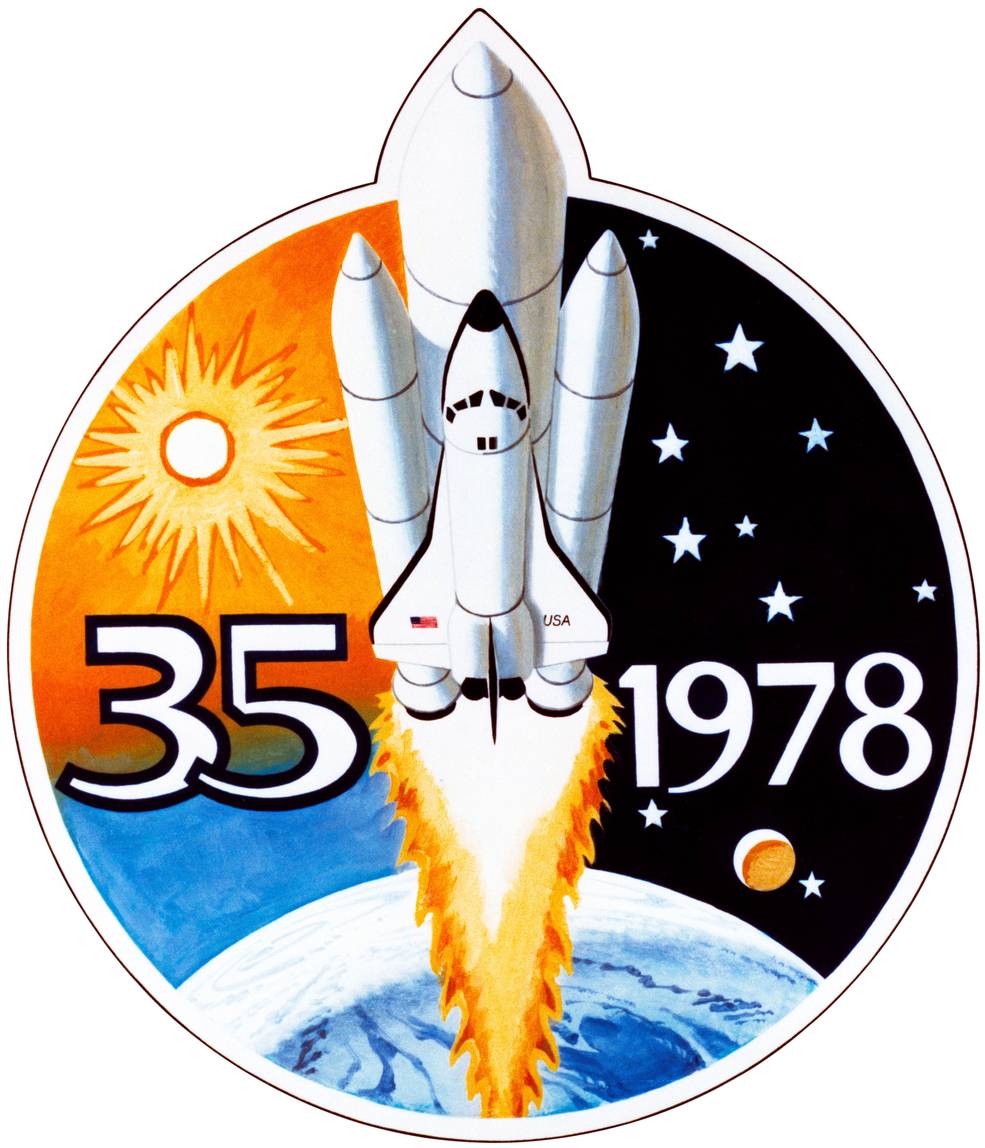


Left: The patch of the Astronaut Class of 1978. Middle: McCall’s original 1973 sketch
for Mission Control. Right: Today’s patch of the JSC Flight Operations Directorate.
A longtime resident of Arizona, McCall often included images of his adopted state in his paintings, such as the Grand Canyon or the sunrise state flag. But visions of space and the future remained hallmarks of his inspiring work. McCall died on Feb. 26, 2010. His work lives on.
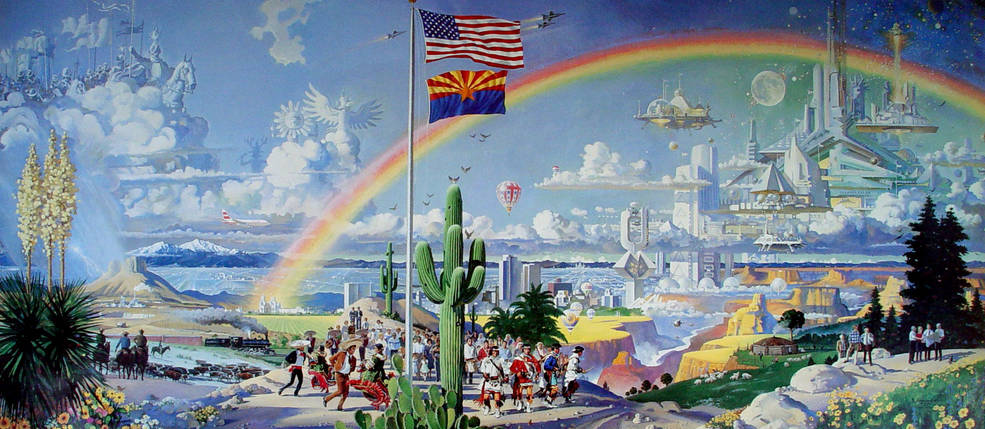
The Spirit of Arizona.
Credits: mccallstudios.com
Read McCall’s oral history with the JSC History Office.
View the illustrated version of the oral history interview with Bob McCall here.
To view gallery of Robert McCall’s paintings, visit – https://roundupreads.jsc.nasa.gov/roundup/1326


























